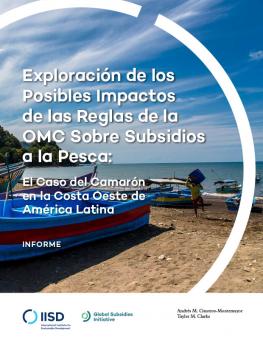
Exploración de los Posibles Impactos de las Reglas de la OMC Sobre Subsidios a la Pesca: El Caso del Camarón en la Costa Oeste de América Latina
Este caso de estudio explora el posible impacto en la pesca de camarón en el Pacífico Oriental Tropical de nuevas reglas sobre los subsidios pesqueros.
Elementos principales
(English below)
- Las pesquerías de camarón en el Pacífico Oriental Tropical son económicamente valiosas, pero han sufrido de sobrecapacidad y de sobrexplotación secuencial.
- De los subsidios concedidos a estas pesquerías, aquellos al combustible parecen ser los más frecuentes; sin embargo, su impacto varía: los subsidios parecen ser importantes para la rentabilidad de algunas flotas camaroneras, pero no parecen significativos para otras.
- De las opciones para las reglas de subsidio consideradas en este estudio, las que podrían tener mayor impacto en estas pesquerías en la región son: aquellas que prohíben los subsidios a la pesca de poblaciones sobreexplotadas (ya que muchas especies de camarones están sobreexplotadas) y los subsidios al combustible, particularmente para aquellas flotas para las cuales estos apoyos parecen ser importante para su rentabilidad.
La Agenda 2030 de las Naciones Unidas para el Desarrollo Sostenible incluye un objetivo específico (Objetivo de Desarrollo Sostenible 14.6) de completar, para 2020, las negociaciones en la Organización Mundial del Comercio (OMC) sobre los subsidios pesqueros. En el contexto de estas negociaciones, se discuten nuevas reglas en tres áreas específicas: (1) subsidios que contribuyen a la pesca ilegal, no declarada y no reglamentada, (2) subsidios a la pesca de poblaciones que ya están sobreexplotadas y (3) subsidios que contribuyen de manera más general a la sobrepesca y al exceso de capacidad. Para esclarecer cómo las posibles reglas a los subsidios podrían aplicarse en la práctica, el Instituto Internacional para el Desarrollo Sostenible ha producido tres estudios que exploran el posible impacto de disciplinas sobre subsidios en tres pesquerías en distintas áreas geográficas.
Este caso de estudio analiza las pesquerías de camarón del Pacífico Oriental Tropical. El estudio empieza por un análisis general de la pesquería y su gobernanza. Luego examina los subsidios que reciben las flotas que pescan camarones y ofrece una evaluación cualitativa del impacto que las diferentes normas de la OMC sobre los subsidios pesqueros podrían tener en esta pesquería. También proporciona información sobre posibles maneras de reformar los subsidios pesqueros dañinos.
Exploring the Potential Impacts of WTO Fisheries Subsidies Rules: The Case of Shrimp on the West Coast of Latin America
Key Messages
- Shrimp fisheries in the Eastern Tropical Pacific are economically valuable, but have suffered from overcapacity and sequential overfishing.
- Fuel subsidies appear to be the most common subsidy provided in these fisheries, but their impact varies: subsidies appear to be important to the profitability of some fleets, but not significant for others.
- Of the options for subsidy rules considered in this study, those that might have the most impact on shrimp fishing in the region are: those that prohibit subsidies for fishing of overfished stocks (as many shrimp species are overexploited) and those to fuel, particularly for those fleets for which fuel subsidies appear to be important to profitability.
The United Nations 2030 Agenda for Sustainable Development includes a specific target (Sustainable Development Goal 14.6) of completing, by 2020, negotiations at the World Trade Organization (WTO) to discipline fisheries subsidies. In the context of these negotiations, new rules are discussed in three specific areas: (1) subsidies that contribute to illegal, unreported and unregulated fishing, (2) subsidies to the fishing of stocks that are already overfished and (3) subsidies that more broadly contribute to overfishing and overcapacity. To help build understanding of how possible subsidy rules might apply in practice, the International Institute for Sustainable Development has produced three case studies to explore the possible impact of such WTO subsidy disciplines in three fisheries in distinct geographical areas.
This case study looks at the shrimp fisheries of the Eastern Tropical Pacific. It provides an overview of the fishery and its governance, examines the subsidy patterns of fleets fishing shrimp and gives a qualitative assessment of the impact that different possible WTO rules on fisheries subsidies could have in this fishery. It also provides insights about potential pathways for the reform of harmful fisheries subsidies.
You might also be interested in
Deep Dive Into Fisheries Subsidies, Part 2: Cheap gas and free nets causing problems for shrimp
Stories of success in Latin American fishing communities have nothing to do with the price of gas or getting cheap equipment. Instead, there must be a system that protects their business from illegal fishing.
How Can We Support Fisheries During the Pandemic?
We must aim to support businesses, incomes, and food security while creating a more sustainable future for fisheries.
Exploring the Possible Impacts of WTO Rules on Fisheries Subsidies: The Case of the Southern Longline Tuna Fishery in the Western and Central Pacific
This case study explores the potential impact of new rules on fisheries subsidies on the southern longline tuna fishery in the Western and Central Pacific ocean.
Une exploration des impacts potentiels des règles de l'OMC sur les subventions à la pêche : Le cas de la pêcherie de sardinelles en Afrique de l'Ouest
Cette étude de cas examine la manière dont de nouvelles règles de l’Organisation mondiale du commerce sur les subventions à la pêche pourraient concrètement affecter la pêcherie de sardinelles au large des côtes ouest-africaines.